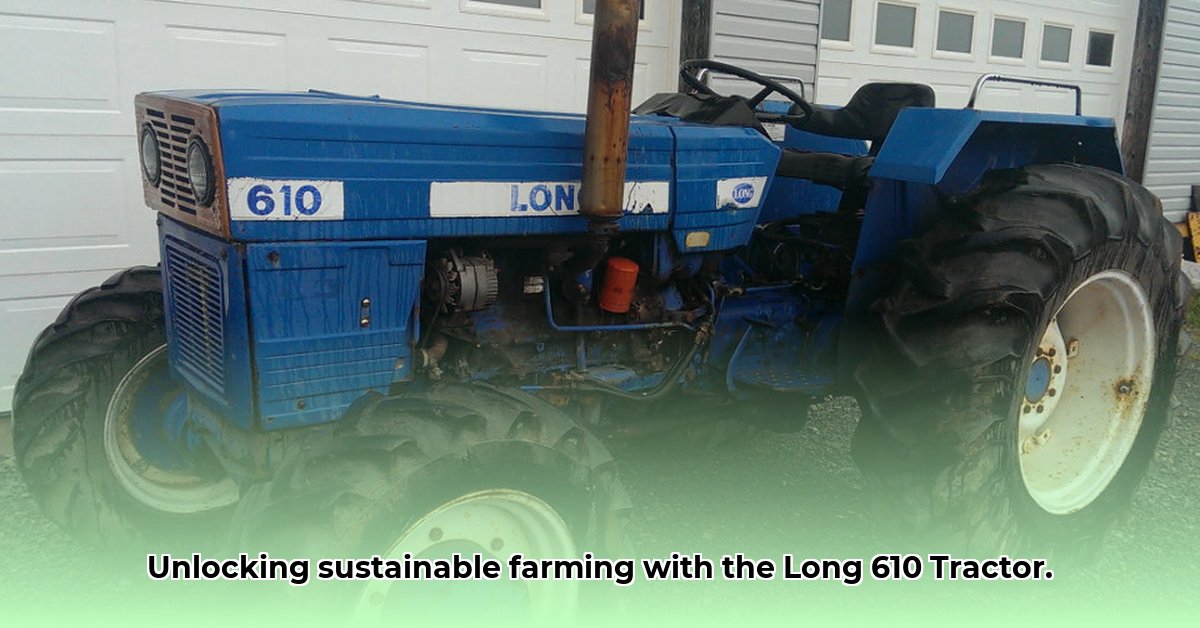
Under the Hood: Engine and Power
The Long 610 tractor, a Romanian workhorse from a bygone era, boasts a 3.6-liter, four-cylinder diesel engine producing approximately 64 horsepower. While significantly less powerful than modern tractors, this lower power output translates to potentially lower fuel consumption—a key factor in sustainable agriculture. This characteristic makes the Long 610 a compelling case study in the relationship between technology, fuel efficiency, and environmental impact. How does this lower horsepower impact overall farm productivity? It's a crucial consideration. For more details, see the Long 610 specs.
Transmission and Drivetrain: Versatility for Sustainable Practices
The Long 610 features an 8-forward, 2-reverse gear transmission, offering considerable versatility for its time. Available in both 2-wheel drive (2WD) and 4-wheel drive (4WD) configurations, farmers could optimize their fuel usage by selecting the appropriate drive type based on the task and field conditions. The ability to utilize 2WD for lighter tasks further enhances fuel efficiency. Could this flexibility compensate for the lower horsepower in terms of operational effectiveness? Let's explore this aspect further.
Fuel Efficiency and Capacity: A Sustainable Approach to Fuel Management
Fuel efficiency is paramount in sustainable farming. The relatively small 14.25-gallon fuel tank of the Long 610 necessitates careful fuel management. This design inherently encourages efficient work planning and prevents unnecessary fuel consumption. The smaller tank capacity prompts more intentional, eco-conscious operation. Does this limitation ultimately force users towards more sustainable farming practices?
Size and Weight: Minimizing Soil Compaction
The Long 610's relatively compact size and lightweight design minimize soil compaction, a significant benefit for soil health and long-term sustainability. Reduced compaction enhances soil aeration and water infiltration, leading to healthier crops. Could this be a significant hidden advantage over more powerful, heavier modern tractors? This deserves consideration.
Maintenance and Repairs: A Trade-off Between Sustainability and Effort
Maintaining a classic tractor like the Long 610 demands more time and effort compared to modern machines. Parts sourcing can be challenging, requiring resourcefulness and potentially specialized repair skills. This increased maintenance burden represents a trade-off. Is the potential longer lifespan and lower initial cost offset by the higher maintenance requirements? This is a crucial question for potential owners.
Long 610 vs. Modern Tractors: A Sustainability Showdown
Comparing the Long 610 to modern tractors reveals a complex picture of sustainability. Modern tractors offer higher horsepower, advanced technology (like GPS guidance), and generally better fuel efficiency per horsepower. However, the Long 610's lower power and fuel usage, coupled with its reduced soil compaction, might make it a suitable option for smaller farms or those emphasizing low-impact practices. Moreover, the environmental impact of producing a new tractor compared to maintaining an older one presents a vital aspect of the sustainability consideration. What's the true environmental footprint?
Long 610 Tractor Specs: At a Glance
| Specification | Details | Impact on Sustainable Farming |
|---|---|---|
| Engine Type | 3.6-liter, four-cylinder diesel | Potentially lower fuel use, reduced emissions. |
| Horsepower | Approximately 64 hp | Suitable for smaller farms, reduced soil compaction. |
| Transmission | 8 forward gears, 2 reverse gears | Good versatility for different tasks. |
| Fuel Tank Capacity | About 14.25 gallons | Demands careful fuel management and planning. |
| Drive Type | 2WD or 4WD options available | Flexibility to match field conditions and tasks. |
| Maintenance Needs | More demanding than modern tractors | Requires more time, effort, and potentially specialized skills. |
The Long 610's specifications highlight a multifaceted perspective on sustainability. It's not merely about horsepower; the entire operational context significantly influences its overall environmental impact. While lacking modern technological advancements, this tractor provides a unique lens through which to examine the historical evolution of agricultural technology and its implications for contemporary sustainable farming practices. Further research into the lifecycle environmental impact of vintage tractors compared to modern alternatives is warranted.
Improving Fuel Efficiency in Your Long 610 Tractor
Optimizing fuel efficiency in a Long 610 tractor necessitates a proactive, multifaceted approach encompassing regular maintenance, efficient operating techniques, and resourceful parts sourcing.
Prioritizing Preventative Maintenance
Regular maintenance is crucial. A well-maintained Long 610 will consume far less fuel than a neglected one. Key aspects include: frequent fuel filter replacement, diligent fuel line inspection and repair, lift pump maintenance, radiator cleaning (essential to prevent overheating and fuel waste), and regular engine tune-ups.
Optimizing Operating Techniques
Efficient operation significantly reduces fuel consumption. Avoid overloading the tractor, and always match engine speed to the task at hand.
Parts Sourcing and Creative Problem-Solving
Locating parts for a Long 610 can be challenging. Online forums and specialized agricultural parts suppliers are valuable resources. Be prepared to adapt parts from similar models if necessary.
Addressing Overheating
Overheating is a significant fuel waster. This underscores the importance of regular radiator cleaning and maintenance.
By implementing these strategies, you can enhance the Long 610's fuel efficiency and contribute to a more sustainable farming approach.